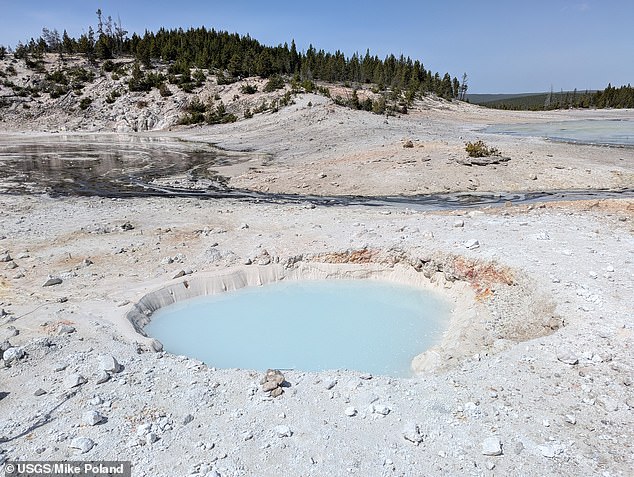
New Yellowstone Basin Vent Discovery Spurs Supervolcano Eruption Risk Evaluation
New Thermal Feature Sparks Interest in Yellowstone’s Supervolcano
Scientists recently discovered a 13-foot thermal pool in Yellowstone National Park’s Norris Geyser Basin, raising questions about the supervolcano’s activity. While the serene, light-blue spring appears otherworldly, experts confirm it formed through mild hydrothermal explosions—not imminent volcanic eruption risks.
Formation of the New Pool
Satellite imagery revealed the pool developed gradually between December 2024 and February 2025. Initially, a depression appeared in January, which expanded into a fully formed pool by mid-February. Rocks and silica mud around its edges suggest multiple small explosions, not a single violent event. The pool’s temperature measures 109°F (43°C), with its vivid hue attributed to mineral-rich, clear water.
[IMAGE: New thermal pool with white silica mud and blue water]
Caption: The pool formed through mild hydrothermal explosions, ejecting rocks and silica mud.
Yellowstone’s Volcanic Context
Yellowstone sits atop one of Earth’s largest active volcanoes, capable of catastrophic eruptions. A full eruption could blanket the U.S. in ash, disrupt climate patterns, and displace millions. However, the park’s geothermal activity—including geysers and hot springs—is normal, reflecting its dynamic underground system.
Dr. Craig Magee, a University of Leeds geologist, explains that isolated events like this new pool don’t signal increased eruption risk. "Yellowstone regularly experiences small earthquakes and ground shifts," he notes. "A single hydrothermal explosion is just a symptom of its active geology."
[IMAGE: Satellite images showing the pool’s formation timeline]
Caption: Satellite data tracks the pool’s emergence from December 2024 to February 2025.
Hydrothermal Explosions: A Hidden Hazard
Hydrothermal explosions occur when underground water rapidly turns to steam, fracturing rock. While dramatic, they’re common in Yellowstone. The new pool’s acidic or salty water poses dangers to visitors, highlighting the importance of staying on marked trails.
Could Yellowstone Erupt Soon?
Despite fears, Yellowstone’s last major eruption was 630,000 years ago. Recent studies place its magma chamber 2.3 miles (12,500 feet) belowground—relatively shallow but not an immediate threat. Scientists monitor for clusters of explosions, sustained seismic activity, or ground uplift as potential warning signs.
[IMAGE: Map showing the pool’s location at Norris Geyser Basin]
Caption: The new feature lies in Norris Basin, Yellowstone’s most dynamic thermal area.
NASA’s Bold Mitigation Idea
A speculative NASA proposal suggests drilling into Yellowstone’s magma chamber to cool it with water, potentially generating geothermal energy. However, experts warn this could accidentally trigger eruptions and would take millennia to impact the volcano.
In Short
While the new thermal pool underscores Yellowstone’s volatility, experts emphasize there’s no cause for alarm. Ongoing monitoring and research aim to understand—not predict—the supervolcano’s complex behavior.
[INFOBOX]
Yellowstone Fast Facts
- 3 states: Idaho, Wyoming, Montana.
- Famous for Old Faithful geyser (erupts every 44–125 mins).
- Magma chamber depth: ~2.3 miles.
- Last major eruption: 630,000 years ago.
[IMAGE: Old Faithful geyser erupting]
Caption: Old Faithful’s predictable eruptions draw millions annually.


